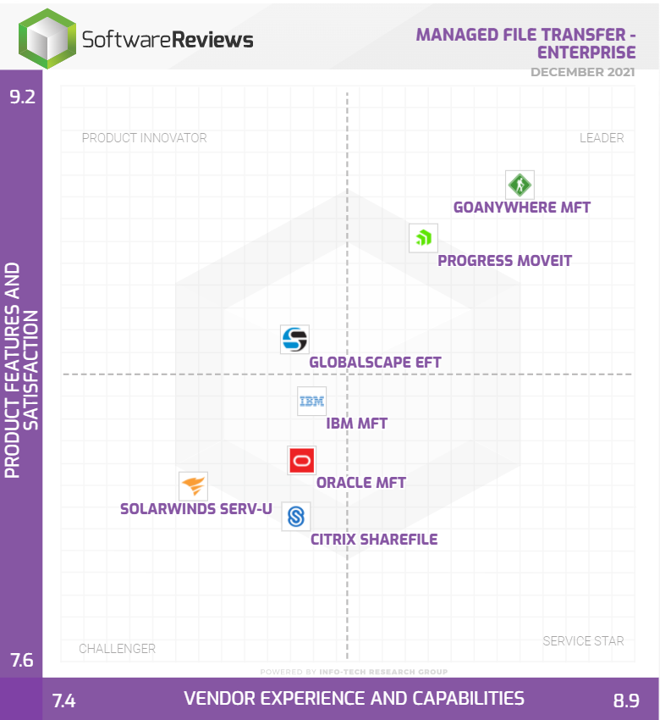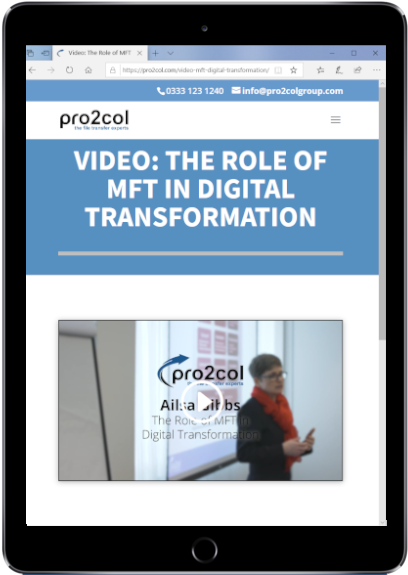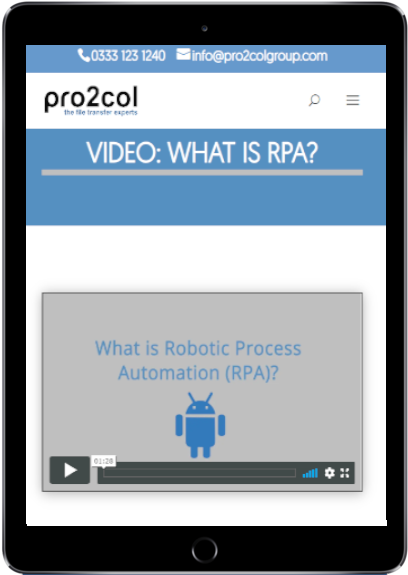 As 2021 draws to a close, Software Reviews have released their latest Info-Tech MFT Data Quadrant. Regular readers of this blog will remember we highlighted concerns about the 2019 report – namely that several of the featured products weren’t actually managed file transfer (see our full 2019 review below ).So, what does the 2021 report look like, and is it a more accurate reflection of the marketplace?
As 2021 draws to a close, Software Reviews have released their latest Info-Tech MFT Data Quadrant. Regular readers of this blog will remember we highlighted concerns about the 2019 report – namely that several of the featured products weren’t actually managed file transfer (see our full 2019 review below ).So, what does the 2021 report look like, and is it a more accurate reflection of the marketplace?
Business Process Automation
Business Process Automation (BPA) is the automation of complex business processes and functions using sophisticated technologies. BPA takes an entire business process and automates it from start to finish. This includes event-driven, mission-critical, core processes. BPA goes well beyond conventional data manipulation and record-keeping activities.
-
-
-
- Chapter 1: What is Business Process Automation?
- Chapter 2: Business Process Automation solutions
- Chapter 3: Resources to help you research Business Process Automation
- Chapter 4: Who uses Business Process Automation?
- Chapter 5: The latest Business Process Automation tips and news
- Chapter 6: Discuss BPA with an expert
-
-
Introduction to Business Process Automation
You’re probably reading this because you’ve been introduced to the term Business Process Automation – or BPA – and you want to find out more. You’re definitely in the right place. Perhaps you’re intrigued about how BPA could transform your business, or you’ve already identified processes that need to be streamlined. Either way, you will learn all about BPA on this page. From how businesses use BPA to what exactly the different types of technology deliver. Of course, if you don’t find the answer you are looking for you can always ask us. First though, it’s important to establish whether Business Process Automation is right for you, so let’s start by defining BPA. Then you can be sure the following information will be useful.

Chapter 1:
What is Business Process Automation?Business Process Automation refers to the use of advanced technology to deliver repeated processes in a business. It refers to the entire process, rather than a single step. Each step in the process automatically triggers the next, so you create entire workflows for core parts of your business. BPA would typically replace manual processes. It minimises costs, improves efficiency and streamlines processes.
Business Process Automation should not to be confused with Business Process Management, which is the discipline of process optimisation to improve agility and performance. BPM is not a type of technology.
BPA is designed to save time, free your staff to focus on other tasks and be able to run continuously with no breaks needed.
There’s a selection of Business Process Automation technology solutions to choose from, depending on which requirements you need to address.
Find out more by clicking on the solutions.
Managed File Transfer
Cloud MFT
Automated File Transfer
Robotic Process Automation
Chapter 3:
Resources to help you research Business Process AutomationVideo: The role of MFT in Digital Transformation
Find out how MFT is the glue supporting your digital transformation. It integrates legacy and new cloud-based systems, automates processes and delivers in-depth reporting and visibility.
Video: What is Robotic Process Automation
Robotic Process Automation (RPA) automates tasks that would ordinarily be done by a person. It is ideal for repetitive manual tasks. Find out how it can help your business become more efficient.
Digital Transformation White Paper
MFT underpins digital transformation. This White Paper explains how it transforms your operational processes through automation, integration, improved visibility, security and compliance.
These case studies are just some examples of how different industries have leveraged the power of Business Process Automation.
Banking
A bank with over a hundred branches and a thousand employees performed most processes manually. This was time consuming and error-prone. Now the bank uses RPA to update customer account information, onboard new employees, complete payroll processes and more. They also automated testing and validation of over 300,000 customer accounts for a core conversion to a new system. They have 75 software robots in production.

Public Sector
A local council uses Managed File Transfer to securely move sensitive information to third-parties. That might include reports concerning a member of the public, or a contractual negotiation with a supplier.
MFT also allows members of the public or suppliers to securely send information to the council. Much like a self-addressed envelope, a council employee can send an empty package to the third party, in which they can place their files and send them back securely.
Finally, it is used instead of email for the simple and rapid transfer of very large or numerous files to suppliers.

Insurance
Closing out each month’s claims is a long manual process for insurance companies. RPA completely transforms this time consuming task. A process automatically starts and runs unattended throughout the night. It will send an email notification in the event of an application malfunction, giving peace of mind.
RPA can also be set up to generate reports for regulatory bodies, who often request them without notice. It integrates with existing applications, like Crystal Reports, the Infinity system and Microsoft Great Plains, providing regulators with the information they request simply and quickly. This faster, more accurate report creation saves multiple employees days of work per month.

Retail
A retail organisation was processing and shipping £250 million of food nationwide each year. But the high volume of orders would tie up their staff with mundane repetitive tasks. Employees were manually faxing customer order files to their warehouse.
The business now uses RPA. Customer order files are transferred automatically to their warehouse. Then RPA runs other essential processes like monitoring supply levels and making SQL updates to their database.
RPA reliably delivers the files on time, without any manual intervention or monitoring.

NHS and the healthcare industry
A medical organisation wanted to remove their reliance on certain file integration protocols owned by their former parent company. They used Managed File Transfer to simplify and manage their automated and manual data transfers. This gave greater control and a more secure, reliable flow of data.
This was particularly important for financial information such as invoices, orders and Bankers’ Automated Clearing Services (BACs) files, among many others.
Managed File Transfer greatly reduced their reliance on multiple solutions.

Managed File Transfer software comparison
Oct 14, 2021 | Blog , Automated File Transfer
 Start your Managed File Transfer software comparison. Answer a series of questions about your business requirements. We’ll compare how the different solutions meet your needs and make a free recommendation.
Start your Managed File Transfer software comparison. Answer a series of questions about your business requirements. We’ll compare how the different solutions meet your needs and make a free recommendation.
Solarwinds Serv-U MFT Server review
Sep 25, 2023 | Blog , Managed File Transfer , Pro2col
 We review Solarwinds Serv-U MFT Server and ask the question is it actually MFT and should it be seen as a leader in the market?
We review Solarwinds Serv-U MFT Server and ask the question is it actually MFT and should it be seen as a leader in the market?
Contact us
We're always happy to help - however big or small your query
Simply fill out this form and one of our BPA specialists will be in touch to discuss your requirements or answer any questions.
Simply call or email us and one of our system integration specialists will be in touch to discuss your requirements or queries.
 0333 123 1240
0333 123 1240
 info@pro2colgroup.com
info@pro2colgroup.com
FAQ's
The basics
What business processes can be automated?
You can automate almost any business process. Examples include invoicing, payroll, sales orders, account reconciliation and many more. Common automated tasks include report generation, managing user accounts, web browser tasks, data extraction, automated file transfer processes and cloud automation.
What does Business Process Automation mean?
Business Process Automation means using advanced technology to deliver entire business processes. You create a complete automated workflow to deliver a process from start to finish, replacing manual processes.
What are the benefits of Business Process Automation?
BPA replaces repetitive manual processes so it minimises costs, improves efficiency and streamlines processes. Staff have more time to work on tasks that add value to the organisation.
What does system integration consists of?
System integration consists of connecting separate systems. This allows information to pass between those systems uninterrupted. If needed the data is transformed into a format the target system can ingest. This allows multiple disparate systems to act as one co-ordinated system.


